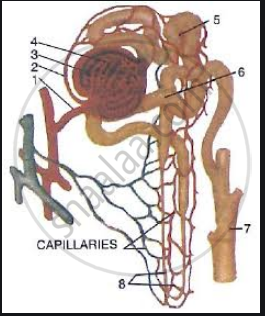Advertisements
Advertisements
Question
Name the Following
The substance found in excess in the urine of a diabetic patient.
Solution
Glucose, Sugar
APPEARS IN
RELATED QUESTIONS
Match structures given in Column I with functions given in Column II.
| Column I | Column II | ||
| (i) | Stomata | (a) | Absorption of water |
| (ii) | Xylem | (b) | Transpiration |
| (iii) | Root hairs | (c) | Transport of food |
| (iv) | Phloem | (d) | Transport of water |
| (e) | Synthesis of carbohydrates |
The nephrons discharge their urine at ______.
Name the main nitrogenous waste in the human blood. How is it removed from the blood?
Choose the correct answer:
What happens if one kidney is removed from the body of human being?
Choose the correct answer:
The smallest functional unit of the kidney is ____________
The following diagram represents a mammalian kidney tubule (nephron) and its blood supply.

Parts indicated by the guidelines 1to 8 are as follows:
1. Afferent arteriole from renal artery
2. Efferent arteriole
3. Bowman's capsule
4. Glomerulus
5. Proximal convoluted tubule with blood capillaries
6. Distal convoluted tubule with blood capillaries
7. Collecting tubule
8. U-shaped loop of Henle
Study the diagram and answer the question that follow:
Which structure (normally) contains the lowest concentration of glucose?
Draw a labeled diagram of the human kidney as seen in a longitudinal section.
State the Location: Renal pyramids
Choose the Odd One Out:
Why is the rate of breathing in aquatic organisms much faster than in terrestrial organisms?
